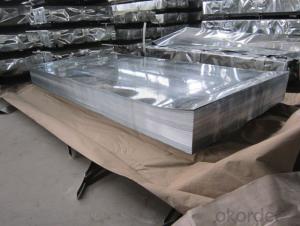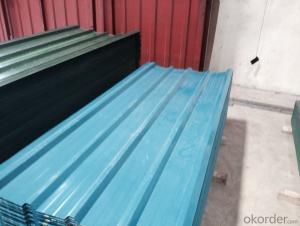Hot-dipped Galvanized Steel Sheet in Sheets
- Loading Port:
- Tianjin
- Payment Terms:
- TT OR LC
- Min Order Qty:
- 50 m.t.
- Supply Capability:
- 1500 m.t./month
OKorder Service Pledge
OKorder Financial Service
You Might Also Like
Description:
The most external layer is all zinc, but successive layers are a mixture of zinc and iron, with an interior of pure steel. These multiple layers are responsible for the amazing property of the metal to withstand corrosion-inducing circumstances. Zinc also protects the steel by acting as a "sacrificial layer." If rust does take hold on the surface of Galvanized Steel Coil, the zinc will get corroded first. This allows the zinc that is spread over the breach or scratch to prevent rust from reaching the steel.
Architecture Roofs and outside walls of civilian and industrial buildings, garage doors, fencings and window blinds.
1. Good Resistance to Corrosion
2. Qualified Processing Machinability
3. High Thermal Resistance
4. Excellent Reflectivity
5. Inexpensive and effective enough
6. Can be recycled and reused multiple times
Application:
With excellent cold bending molded manufacturablity, good decoration effect, strong anti-corrosion ability, galvanized steel coils and sheets are also pollution-free and easily recycled. Accordingly, they can be used as final products and basic plates of color coated steel coils and widely applied in construction, home appliances, decoration.
Construction, packaging, railway vehicles, agricultural machinery and daily life.
Oiled/dry, Skin-pass/Nonskin-pass, Regular/Minimize/Zero Spangle
For countless outdoor, marine, or industrial applications, Galvanized Steel Coil is an essential fabrication component.
Architecture Roofs and outside walls of civilian and industrial buildings, garage doors, fencings and window blinds.
Appliances Industry Outer clad sheets for washing machine, refrigerator, television, air conditioner and ventilation system, explosion-proof strip, solar water heater and appliance parts.
Auto Industry Muffler, heat shields of exhaust pipe and catalytic converter, auto parts & accessories under the frame, signboard in highway
Industrial Instruments Electric control cabinet, industrial refrigeration equipment, automatic vending machine
Product Specification:
Base sheet : galvanized steel sheet, pre painted galvanized steel sheet
Zinc:40G-275G
Thickness:0.12mm-3.2mm
Width:600mm-1500mm
Length:1000mm-11800mm or as request
Package:Standard seaworthy export packing: 3 layers of packing, inside is kraft paper,water plastic film is in the middle and outside GI steel sheet to be covered by steel strips with lock.
FAQ:
1.How many pieces for one ton of the Hot-dip Galvanized Steel Sheet?
The pieces for one tone is decided by the thickness of the sheet, but we can make it according to your requirements in the reasonable range.
2. Do you have pallets for the package?
Yes, we must use pallets for the package in order to load.
3. How many tons do you load in one 20’FCL?
Usually we can load 26tons in one 20’FCL container.
- Q: Can steel sheets be used for electrical motor laminations?
- No, steel sheets are not typically used for electrical motor laminations. Instead, materials such as silicon steel or other electrical grade laminations are commonly employed due to their magnetic properties and ability to reduce energy loss in the motor.
- Q: What are the different embossing options available for steel sheets?
- There are several embossing options available for steel sheets, including blind embossing, deep embossing, pattern embossing, and textured embossing.
- Q: What is the difference between a smooth and diamond plate steel sheet?
- A smooth steel sheet refers to a sheet of steel that has a flat, even surface without any raised patterns or textures. It is typically manufactured through a process that involves rolling the steel and then smoothing it out to create a uniform appearance. Smooth steel sheets are often used in applications where aesthetics and a clean, polished look are desired, such as in architectural projects or for decorative purposes. On the other hand, a diamond plate steel sheet, also known as tread plate or checker plate, has a raised pattern of diamonds or lines embossed onto its surface. This pattern not only adds visual appeal but also provides enhanced traction and grip, making it ideal for applications that require slip resistance or protection against slipping hazards. Diamond plate steel sheets are commonly used in industrial settings, such as on ramps, stairs, or walkways, where there is a need for increased safety and stability. In terms of functionality, the main difference between a smooth and diamond plate steel sheet lies in their surface texture and the specific purposes they serve. While smooth steel sheets prioritize a sleek appearance, diamond plate steel sheets prioritize functionality and safety.
- Q: Can steel sheets be used for garage doors?
- Yes, steel sheets can be used for garage doors. They are commonly used due to their durability, strength, and resistance to weather conditions.
- Q: How do steel sheets perform in terms of thermal conductivity?
- Steel sheets have a relatively high thermal conductivity, meaning they are able to transfer heat efficiently.
- Q: What is the thermal conductivity of stainless steel sheets?
- The thermal conductivity of stainless steel sheets ranges from approximately 14.4 to 19.0 watts per meter-kelvin (W/m·K), depending on the specific grade and composition of the stainless steel.
- Q: What is the weight of a standard steel sheet?
- The weight of a standard steel sheet can vary depending on its dimensions and thickness. However, a commonly used gauge is 20, which has a weight of approximately 9.81 pounds per square foot.
- Q: Are steel sheets suitable for exterior cladding?
- Indeed, exterior cladding can be accomplished with steel sheets. Steel, as a material, possesses durability and strength, rendering it capable of enduring diverse weather conditions such as intense sunlight, torrential rain, and extreme temperatures. It exhibits resistance towards corrosion and avoids warping or rotting, unlike alternative materials. Steel sheets further offer an array of colors and finishes, catering to a broad spectrum of design possibilities. Moreover, the installation and maintenance of steel cladding are effortless, thereby contributing to its widespread usage for exterior purposes. Consequently, steel sheets offer a dependable and visually appealing choice for exterior cladding.
- Q: What is the price range for steel sheets?
- The price range for steel sheets can vary greatly depending on factors such as the size, thickness, quality, and market conditions. However, generally speaking, steel sheets can range anywhere from $30 to $150 per sheet.
- Q: Are steel sheets suitable for interior design applications?
- Yes, steel sheets are suitable for interior design applications. They provide a sleek and modern look to spaces and can be used in various ways such as wall cladding, countertops, backsplashes, and furniture. Steel sheets are durable, easy to clean, and can be customized in terms of finishes and textures to match different design styles.
Send your message to us
Hot-dipped Galvanized Steel Sheet in Sheets
- Loading Port:
- Tianjin
- Payment Terms:
- TT OR LC
- Min Order Qty:
- 50 m.t.
- Supply Capability:
- 1500 m.t./month
OKorder Service Pledge
OKorder Financial Service
Similar products
Hot products
Hot Searches
Related keywords




























